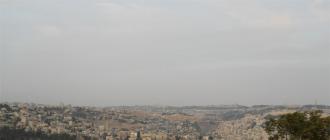Good day!
Almost each of us has found ourselves in a situation where you are wandering in an unfamiliar part of the city and trying to find required address. Now, of course, technology has stepped forward and an ordinary smartphone allows you to navigate the area perfectly...
However, not everywhere and not everything is depicted on Google and Yandex maps. Not long ago I was in a new part of my city, and, as it turned out, some streets in this area were simply not shown on the map. How can you tell another person where you are and how to find you? 
Actually, this short note is dedicated to coordinates and searching for a specific point on the map using map services from Yandex and Google. So...
How to determine your coordinates and how to find an address using coordinates
I'll start with Google maps, official website :
For precise definition your coordinates - click on the “Location Determination” button, usually a small window immediately pops up in the browser asking whether to allow access (select “I allow”).

Important! By the way, in some cases different services can show you in " different places". Therefore, double-check your coordinates using 2 maps at once.
If the street is long and there are no house numbers (or Google maps do not indicate houses in this area at all) - then left-click on the point next to the one identified by Google - a small tab should pop up at the bottom, in which your coordinates!
Coordinates represent consists of two numbers. For example, in the screenshot below these are: 54.989192 and 73.319559
Knowing these numbers, you can transmit your location to anyone (even if he does not use Google maps, which is very convenient).

To find the desired point in Google by coordinates, simply open maps and enter these two numbers in the search bar (top left): after 1-2 seconds. A red flag will light up on the maps indicating the desired point.

Please note:
- coordinates must be indicated using a dot, not a comma (correct: 54.989192 73.319559; incorrect: 54.989192 and 73.319559);
- indicate the coordinates in the order in which the map gives them to you: i.e. first latitude, then longitude (if you break the order, you will get a completely wrong point, perhaps even 1000 km further than the one you are looking for...);
- coordinates can be specified in degrees and minutes (example: 51°54" 73°31").
Yandex maps
By and large, the principle of operation with Yandex maps is similar. It is worth noting that if the address is not determined for one service, try using another. Sometimes, if a street or area is not drawn in Google maps, then in Yandex, on the contrary, it is displayed quite fully, all the streets are signed, and you can easily find your way where to go and what to do.
Yandex Maps also has special ones. a tool that allows you to find out your location online (click on the arrow in the white circle on the right, see screenshot below).

To determine the coordinates - just click on the desired point on the map - a small window will pop up with addresses and two numbers - this is what they are.

You can insert both a specific address and coordinates into the search line (don’t forget that they need to be specified correctly: do not confuse the sequence, specify through a dot, not a comma!).

Addition!
I have another article of a similar nature on my blog - about determining distances between cities, choosing the optimal road and estimating travel time. It will be useful to anyone who is planning to travel to another city, I recommend:
Additions are welcome...
Similar coordinates are used on other planets, as well as on the celestial sphere.
Latitude
Latitude- angle φ between the local zenith direction and the equatorial plane, measured from 0° to 90° on both sides of the equator. The geographic latitude of points located in the northern hemisphere (northern latitude) is usually considered positive, the latitude of points in the southern hemisphere is considered negative. It is customary to speak of latitudes close to the poles as high, and about those close to the equator - as about low.
Due to the difference in the shape of the Earth from a sphere, the geographic latitude of points differs somewhat from their geocentric latitude, that is, from the angle between the direction to a given point from the center of the Earth and the plane of the equator.
The latitude of a place can be determined using astronomical instruments such as a sextant or gnomon (direct measurement), or you can use GPS or GLONASS systems (indirect measurement).
Video on the topic
Longitude
Longitude- dihedral angle λ between the plane of the meridian passing through a given point and the plane of the initial prime meridian from which longitude is measured. Longitude from 0° to 180° east of the prime meridian is called eastern, and to the west is called western. Eastern longitudes are considered to be positive, western longitudes are considered negative.
Height
To completely determine the position of a point in three-dimensional space, a third coordinate is needed - height. The distance to the center of the planet is not used in geography: it is convenient only when describing very deep regions of the planet or, on the contrary, when calculating orbits in space.
Within the geographical envelope it is usually used altitude, measured from the level of the “smoothed” surface - geoid. Such system of three coordinates turns out to be orthogonal, which simplifies a number of calculations. Altitude above sea level is also convenient because it is related to atmospheric pressure.
Distance from earth's surface(up or down) is often used to describe a place, but "not" serves as a coordinate.
Geographic coordinate system
ω E = − V N / R (\displaystyle \omega _(E)=-V_(N)/R) ω N = V E / R + U cos (φ) (\displaystyle \omega _(N)=V_(E)/R+U\cos(\varphi)) ω U p = V E R t g (φ) + U sin (φ) (\displaystyle \omega _(Up)=(\frac (V_(E))(R))tg(\varphi)+U\sin(\ varphi)) where R is the radius of the earth, U is the angular velocity rotation of the earth, V N (\displaystyle V_(N))- vehicle speed to the north, V E (\displaystyle V_(E))- to the east, φ (\displaystyle \varphi )- latitude, λ (\displaystyle \lambda)- longitude.
The main disadvantage in practical application G.S.K. in navigation is the large magnitude of the angular velocity of this system in high latitudes, increasing to infinity at the pole. Therefore, instead of G.S.K., semi-free in azimuth SK is used.
Semi-free in azimuth coordinate system
Semi-free in azimuth S.K. differs from G.S.K. only by one equation, which has the form:
ω U p = U sin (φ) (\displaystyle \omega _(Up)=U\sin(\varphi))Accordingly, the system also has an initial position, carried out according to the formula
N = Y w cos (ε) + X w sin (ε) (\displaystyle N=Y_(w)\cos(\varepsilon)+X_(w)\sin(\varepsilon)) E = − Y w sin (ε) + X w cos (ε) (\displaystyle E=-Y_(w)\sin(\varepsilon)+X_(w)\cos(\varepsilon))In reality, all calculations are carried out in this system, and then, to produce output information, the coordinates are converted into the GSK.
Geographic coordinate recording formats
Any ellipsoid (or geoid) can be used to record geographic coordinates, but WGS 84 and Krasovsky (in the Russian Federation) are most often used.
Coordinates (latitude from −90° to +90°, longitude from −180° to +180°) can be written:
- in ° degrees as a decimal (modern version)
- in ° degrees and ′ minutes with decimal fraction
- in ° degrees, ′ minutes and
To determine latitude It is necessary, using a triangle, to lower a perpendicular from point A to the degree frame onto the line of latitude and read the corresponding degrees, minutes, seconds on the right or left along the latitude scale. φА= φ0+ Δφ
φА=54 0 36 / 00 // +0 0 01 / 40 //= 54 0 37 / 40 //
To determine longitude you need to use a triangle to lower a perpendicular from point A to the degree frame of the line of longitude and read the corresponding degrees, minutes, seconds from above or below.
Determining the rectangular coordinates of a point on the map
The rectangular coordinates of the point (X, Y) on the map are determined in the square of the kilometer grid as follows: 
1. Using a triangle, perpendiculars are lowered from point A to the kilometer grid line X and Y and the values are taken XA=X0+Δ X; UA=U0+Δ U
For example, the coordinates of point A are: XA = 6065 km + 0.55 km = 6065.55 km;
UA = 4311 km + 0.535 km = 4311.535 km. (the coordinate is reduced);
Point A is located in the 4th zone, as indicated by the first digit of the coordinate at given.
9. Measuring the lengths of lines, directional angles and azimuths on the map, determining the angle of inclination of the line specified on the map.
Measuring lengths
To determine on a map the distance between terrain points (objects, objects), using a numerical scale, you need to measure on the map the distance between these points in centimeters and multiply the resulting number by the scale value. 
A small distance is easier to determine using a linear scale. To do this, it is enough to apply a measuring compass, the opening of which is equal to the distance between given points on the map, to a linear scale and take a reading in meters or kilometers. 
To measure curves, the “step” of the measuring compass is set so that it corresponds to an integer number of kilometers, and an integer number of “steps” is plotted on the segment measured on the map. The distance that does not fit into the whole number of “steps” of the measuring compass is determined using a linear scale and added to the resulting number of kilometers.
Measuring directional angles and azimuths on a map
.

We connect points 1 and 2. We measure the angle. The measurement is carried out using a protractor, it is located parallel to the median, then the angle of inclination is reported clockwise.
Determining the angle of inclination of a line specified on the map.
The determination follows exactly the same principle as finding the directional angle.
10. Direct and inverse geodetic problem on a plane. When computationally processing measurements taken on the ground, as well as when designing engineering structures and making calculations to transfer projects into reality, the need arises to solve direct and inverse geodetic problems. Direct geodetic problem . By known coordinates X 1 and at 1 point 1, directional angle 1-2 and distance d 1-2 to point 2 you need to calculate its coordinates X 2 ,at 2 .
|
|
Rice. 3.5. To the solution of direct and inverse geodetic problems |
The coordinates of point 2 are calculated using the formulas (Fig. 3.5): (3.4) where X,atcoordinate increments equal to
![]() (3.5)
(3.5)
Inverse geodetic problem .
By known coordinates X 1 ,at 1 points 1 and X 2 ,at 2 points 2 need to calculate the distance between them d 1-2 and directional angle 1-2. From formulas (3.5) and Fig. 3.5 it is clear that. (3.6) To determine the directional angle 1-2, we use the arctangent function. At the same time, we take into account that computer programs and microcalculators give the main value of the arctangent=  , lying in the range90+90, while the desired directional anglecan have any value in the range 0360.
, lying in the range90+90, while the desired directional anglecan have any value in the range 0360.
The formula for transition from kdepends on the coordinate quarter in which the given direction is located or, in other words, on the signs of the differences y=y 2 y 1 and x=X 2 X 1 (see table 3.1 and figure 3.6). Table 3.1

Rice. 3.6. Directional angles and main arctangent values in the I, II, III and IV quarters
The distance between points is calculated using the formula
(3.6) or in another way - according to the formulas ![]() (3.7)
(3.7)
In particular, electronic tacheometers are equipped with programs for solving direct and inverse geodetic problems, which makes it possible to directly determine the coordinates of observed points during field measurements and calculate angles and distances for marking work.
Sometimes you may need to accurately calculate the geographic coordinates of your location or some object, but you have nothing with you except a map. It is not difficult to learn how to determine latitude and longitude on a map; you just need to get a clear understanding of what the coordinate system is and how to work with it.
The coordinate system is a kind of geographic “registration” that any point on the planet has. A grid of meridians and parallels, applied over the canvas of any image of the area, helps determine the latitude and longitude of the desired object from the map. Let's look at how it can be used to search for a geographic location.
What is a coordinate system?
People invented a system that reads the coordinates of any point a long time ago. This system consists of parallels indicating latitude and meridians indicating longitude.
Since it was difficult to determine latitude and longitude by eye, a grid of longitudinal and transverse arcs, indicated by numbers, began to be applied over all types of geographical images.
What does latitude mean?
The number responsible for the latitude of a place on the map indicates its distance relative to the equator - the further the point is from it and the closer to the pole, the more its digital value increases.
- On flat images, as well as on globes, latitude is determined by spherical lines drawn horizontally and parallel to the equator - parallels.
- At the equator there is a zero parallel, towards the poles the value in numbers increases.
- Parallel arcs are designated in degrees, minutes, seconds, as angular measurements.
- From the equator towards the north pole, the value will have positive values from 0º to 90º, indicated by the symbols “n. latitude,” that is, “north latitude.”
- And from the equator towards the south - negative, from 0º to -90º, indicated by the symbols “southern latitude”, that is, “southern latitude”.
- The values 90º and -90º are at the peak of the poles.
- Latitudes close to the equator are called “low”, and those close to the poles are called “high”.
To determine the location of the required object relative to the equator, you just need to correlate its point with the nearest parallel, and then look at what number is opposite it to the left and right behind the map field.
- If the point is located between the lines, you must first determine the nearest parallel.
- If it is north of the desired point, then the coordinate of the point will be smaller, so from the nearest horizontal arc you need to subtract the difference in degrees to the object.
- If the nearest parallel is below the desired point, then the difference in degrees is added to its value, since the desired point will have a larger value.
Since it is sometimes difficult to determine latitude and longitude on a map at a glance, they use a ruler with a pencil or compass.
Remember! All points on the globe, and accordingly on a map or globe, located along one parallel arc will have the same value in degrees.
What does longitude mean?
Meridians are responsible for longitude - vertical spherical arcs converging at the poles into one point, dividing the globe into 2 hemispheres - western or eastern, which we are used to seeing on the map in the form of two circles.
- Meridians similarly facilitate the task of accurately determining the latitude and longitude of any point on earth, since the place of their intersection with each of the parallels is easily indicated by a digital mark.
- The value of vertical arcs is also measured in angular degrees, minutes, seconds, ranging from 0º to 180º.
- Starting from 1884, it was decided to take the Greenwich meridian as the zero mark.
- All coordinate values in the direction west of Greenwich are designated by the symbol “W,” that is, “western longitude.”
- All values in the direction east of Greenwich are designated by the symbol “E,” that is, “Eastern longitude.”
- All points located along the same meridian arc will have the same designation in degrees.
Remember! To calculate the longitude value, you need to correlate the location of the desired object with the digital designation of the nearest meridian, which is placed outside the image fields above and below.
How to find the coordinates of the desired point
The question often arises of how to determine latitude and longitude on a map if the desired point, distant from the coordinate grid, is located inside a square.
Calculating coordinates is also difficult when the image of the area is on a huge scale, and you don’t have more detailed information with you.
- Here you cannot do without special calculations - you will need a ruler with a pencil or a compass.
- First, the nearest parallel and meridian are determined.
- Their digital designation is recorded, then the step.
- Next, the distance from each of the arcs is measured in millimeters, then converted to kilometers using a scale.
- All this correlates with the pitch of parallels, as well as the pitch of meridians drawn on a certain scale.
- There are images with different pitches - 15º, 10º, and there are less than 4º, this directly depends on the scale.
- Having found out the distance between the nearest arcs, also the value in degrees, you need to calculate the difference, by how many degrees a given point is deviated from the coordinate grid.
- Parallel - if the object is in the northern hemisphere, then we add the resulting difference to the smaller number, and subtract it from the larger one; for the southern hemisphere, this rule works similarly, only we carry out the calculations as with positive numbers, but the final number will be negative.
- Meridian - position given point in the eastern or western hemisphere it does not affect the calculations; we add our calculations to the smaller value of the parallel, and subtract from the larger value.
Using a compass is also easy to calculate the geographic location - to get the value of the parallel, its ends need to be placed on the point of the desired object and the nearest horizontal arc, and then the thrust of the compass must be transferred to the scale of the existing map. And to find out the size of the meridian, repeat all this with the nearest vertical arc.
Video lesson “Geographical latitude and geographic longitude. Geographic coordinates» will help you get an idea of geographic latitude and geographic longitude. The teacher will tell you how to correctly determine geographic coordinates.
Geographic latitude- arc length in degrees from the equator to a given point.
To determine the latitude of an object, you need to find the parallel on which this object is located.
For example, the latitude of Moscow is 55 degrees and 45 minutes north latitude, it is written like this: Moscow 55°45"N; latitude of New York - 40°43"N; Sydney - 33°52" S
Geographic longitude is determined by meridians. Longitude can be western (from the 0 meridian to the west to the 180 meridian) and eastern (from the 0 meridian to the east to the 180 meridian). Longitude values are measured in degrees and minutes. Geographic longitude can have values from 0 to 180 degrees.
Geographic longitude- length of the equatorial arc in degrees from the prime meridian (0 degrees) to the meridian of a given point.
The prime meridian is considered to be the Greenwich meridian (0 degrees).

Rice. 2. Determination of longitudes ()
To determine longitude, you need to find the meridian on which a given object is located.
For example, the longitude of Moscow is 37 degrees and 37 minutes east longitude, it is written like this: 37°37" east; the longitude of Mexico City is 99°08" west.

Rice. 3. Geographical latitude and geographic longitude
To accurately determine the location of an object on the surface of the Earth, you need to know its geographic latitude and geographic longitude.
Geographic coordinates- quantities that determine the position of a point on the earth’s surface using latitudes and longitudes.
For example, Moscow has the following geographic coordinates: 55°45"N and 37°37"E. The city of Beijing has the following coordinates: 39°56′ N. 116°24′ E First the latitude value is recorded.
Sometimes you need to find an object at already given coordinates; to do this, you must first guess in which hemispheres the given object is located.
Homework
Paragraphs 12, 13.
1. What are geographic latitude and longitude?
References
Main
1. Basic course in geography: Textbook. for 6th grade. general education institutions / T.P. Gerasimova, N.P. Neklyukova. - 10th ed., stereotype. - M.: Bustard, 2010. - 176 p.
2. Geography. 6th grade: atlas. - 3rd ed., stereotype. - M.: Bustard, DIK, 2011. - 32 p.
3. Geography. 6th grade: atlas. - 4th ed., stereotype. - M.: Bustard, DIK, 2013. - 32 p.
4. Geography. 6th grade: cont. cards. - M.: DIK, Bustard, 2012. - 16 p.
Encyclopedias, dictionaries, reference books and statistical collections
1. Geography. Modern illustrated encyclopedia / A.P. Gorkin. - M.: Rosman-Press, 2006. - 624 p.
Literature for preparing for the State Exam and the Unified State Exam
1. Geography: initial course. Tests. Textbook manual for 6th grade students. - M.: Humanite. ed. VLADOS center, 2011. - 144 p.
2. Tests. Geography. 6-10 grades: Educational and methodological manual/ A.A. Letyagin. - M.: LLC "Agency "KRPA "Olympus": "Astrel", "AST", 2001. - 284 p.
Materials on the Internet
1. Federal Institute of Pedagogical Measurements ().
2. Russian Geographical Society ().







